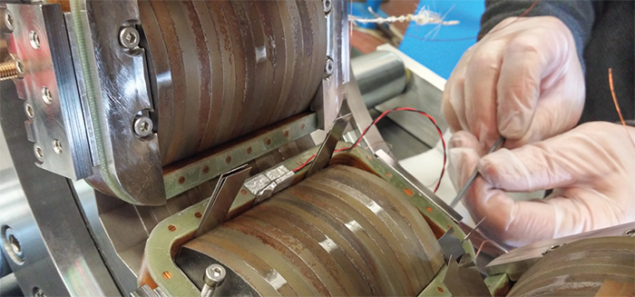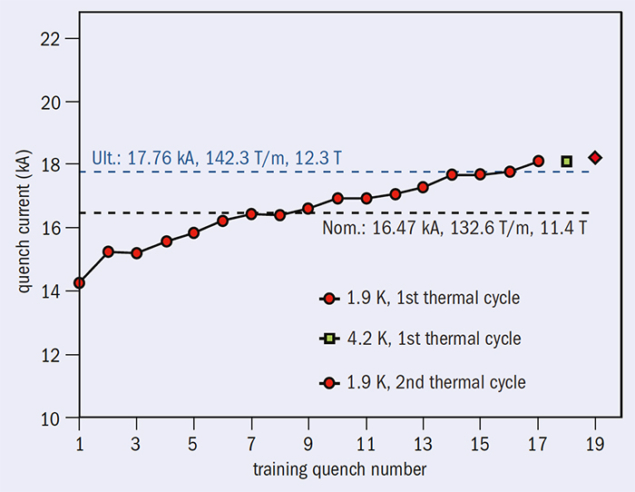The first components for the HL-LHC are successfully passing the tests.

Image credit: LASA Laboratory.
To obtain 10 times the LHC original design luminosity, the HL-LHC will need to replace more than 40 large superconducting magnets, in addition to about 60 superconducting corrector magnets. A wealth of innovative magnet technologies will be exploited to ensure the final performance of the new machine. Two key features are of paramount importance for the whole project: the production of high magnetic fields and the stability and reliability of the various components.
The backbones of the upgrade are the 24 new focussing quadrupoles (inner triplets) that will be installed at both ends of the ATLAS (Point 1) and CMS (Point 5) interaction regions. These magnets will provide the final beam squeeze to maximise the collision rate in the experiments. They are particularly challenging, because they will have to reach a field of nearly 12 T with an aperture that is more than double that of the current triplets.
In its final configuration, the new machine will have 36 new superferric corrector magnets, of which four will be quadrupoles, and 32 higher-order magnets, up to the dodecapoles. These magnets will also feature a much larger aperture than the ones currently used in the LHC. However, they are designed to be more stable and reliable, to stand the tougher operating conditions of the new machine.
The HL-LHC will also need a more efficient collimation system, because the present one will not be sufficient to handle the new beam intensity, which is twice the LHC nominal design value. For this reason, powerful dipoles will be installed at Point 7 of the ring, in the dispersion-suppression region. The idea is to replace an 8 T, 15 m-long standard LHC dipole with two 11 T, 5.5 m-long new dipoles, therefore achieving the same beam bending strength, but making space to allow the insertion of new collimators in the 4 m central slot. The new dipoles will have a peak field approaching 12 T, comparable to the new inner triplet quadrupoles.
Superferric: strong and reliable
The first HL-LHC magnet, ready and working according to specifications, is a sextupole corrector. This first component is also rather unique because, unlike the superconducting magnets currently used in the LHC, it relies on a “superferric” heart.
Although the name might sound unfamiliar, superferric magnets were initially proposed in the 1980s as a possible solution for high-energy colliders. However, many technical problems had to be overcome, and a good opportunity had to show up, before the use of superferric magnets could become a reality.

Image credit: CERN.
In a standard superconducting magnet, the iron is used only in the yoke, while in a superferric (or “iron-dominated”) magnet, iron is also used in the poles that shape the field, much like classical resistive magnets. In the HL-LHC superferric correctors, the coils are made of Nb-Ti superconductor and will be operated at 1.9 K. The superferric design was selected among other options because it has a sharp fringe field and is very robust. This requirement is crucial for HL-LHC, where it will be essential to sustain the increased radioactive load caused by the collisions of the high-intensity beams.
A superferric corrector magnet had been developed by CIEMAT for the sLHC-PP study (the study that preceded that of the HL-LHC, see project-slhc.web.cern.ch/project-slhc/), and that design was used as a starting point for the HL-LHC correctors. Subsequently, in the framework of a collaboration agreement for the HL-LHC project signed in 2013 between CERN and the Italian National Institute for Nuclear Physics (INFN), the LASA laboratory of the Milan section of the INFN has taken over as a partner in the project.
Recent tests carried out at LASA showed that the sextupole corrector magnet is highly stable, because it could reach and surpass the ultimate current value of 150 A (132 A being the nominal operating value) required by the design specifications before quenching. Actually, the first training quench appeared well above 200 A.
Record dipoles
The HL-LHC is an important test bed for a new concept of dipoles. Built using superconducting niobium-tin (Nb3Sn) coils kept at a temperature of 1.9 K, the new dipoles will have to reach a bore field of 11 T in stable conditions.
If the expected requirements will be met, the niobium-tin magnets will be crucial to all future collider machines because, for the time being, this is the only technology able to produce magnetic fields greater than 10 T.
Following up on initial successful tests conducted at Fermilab on single-aperture magnets, CERN’s experts went on to design and manufacture the first 2 m-long model magnet. While relying on the coil technology developed at Fermilab, the CERN magnet includes some new design features: cable insulation made by braiding S2-glass on mica-glass tape, a new material for the coil wedge, more flexible coil end spacers and a new collaring concept for pre-loading the brittle niobium-tin coils.
Magnets reach their nominal operation after “training” – a procedure that pushes the magnet to the highest possible field before it quenches. Quench after quench, the magnets acquire memory of their previous performance and reach higher fields. In January this year, the first double-aperture (two-in-one) dipole has shown a full memory of the single-coil test, and has established a record field for accelerator dipoles reaching a stable operating field of 12.5 T. Even more relevant to future operation in the LHC, it passed a nominal field of 11 T with no quench, and reached the ultimate field of 12 T with only two quenches (see figure 1).
Even if they will be able to produce a much higher field, the HL-LHC 11 T dipoles are very similar to the standard LHC dipoles, because they must fit in the continuous cryostat and must be powered in series with the rest of the LHC dipoles in a sector. In parallel, the members of the HL-LHC project are developing a bypass cryostat to host the new collimators, which will be inserted between two 11 T dipoles. The new components will allow the machine to cope with the increased number of particles drifting out of the primary beam and hitting the magnets in the cleaning insertions of Point 7. The work is so well advanced that the first collimators should be installed in the dispersion suppression region of the LHC ring during the next long shutdown of the machine scheduled for 2019–2020. They will improve the performance of the LHC during Run 3 and will put the new Nb3Sn technology to test, in preparation for the final configuration of the HL-LHC.

Image credit: Fermilab/ LARP and CERN.
With an aperture of 150 mm, the focussing quadrupoles currently being developed by the US-LARP collaboration (BNL, FNAL and LBNL) in collaboration with CERN take advantage of all of the most advanced magnet technologies. Similar to the 11 T dipoles, they use Nb3Sn coils and their operating temperature will be 1.9 K. Because of the high field and large aperture, these magnets store an energy per unit length twice as large as that stored in the LHC dipoles. The mechanical structure to contain forces and to assure the field shape is of a new type, first proposed by LBNL, called “keys & bladders”. Based on force control rather than dimension control, like in the case of a classical “collars” structure, “keys and bladders” is very well suited for the Nb3Sn mechanical characteristics (Nb3Sn is indeed a very brittle material), and it is easy to implement on a limited number of magnets. A special tungsten absorber system, integrated in the beam screen, shields these magnets from the “heavy rain” of collision debris, which will be five times more intense than in the LHC.
At the beginning of March, the LARP teams at Fermilab succeeded in training the first 1.5 m-long model. Designed and manufactured by a CERN–LARP joint team, this is the first accelerator-quality final cross-section model of the inner triplet magnet. Following a very smooth training curve (see figure 2), the model magnet surpassed the operating gradient, which corresponds to a peak field of 11.4 T, actually reaching 12.5 T. Together with the HL-LHC companion 11 T dipole, it is the first built accelerator-quality magnet reaching such fields.
Building on the proven performance of the Nb3Sn technology, experts from both sides of the Atlantic will go on to build the actual-length quadrupoles. At Fermilab, the final US magnets will measure 4.2 m in length, while the CERN team aims at manufacturing 7.2 m-long quadrupoles to halve the number of magnets to be installed.
In addition to ensuring the future of collider physics, for which the success of high-field Nb3Sn for the HL-LHC is a key ingredient, the new powerful magnets will certainly pave the way for their use in other fields, including the medical one. Indeed, the Nb3Sn technology is already at the core of ultra-high-field magnets used in various fields but not yet in magnetic resonance imaging (MRI), which today represents the largest commercial use of superconductivity. However, the hope is that the development of this technology in the HL-LHC machine may also boost wider use of Nb3Sn magnets in the medical sector. Indeed, thanks to the higher magnetic fields that can be achieved with Nb3Sn, MRI systems using this technology would be able to provide more detailed images and faster scanning, e.g. for functional imaging. The challenge is now within reach.








